A two-way mirror (sometimes called a one-way or smart mirror) is commonly seen in TV detective shows where police officers in a dimly lit office secretly observe a suspect being interrogated in a brightly lit interview room. But how exactly does a two-way mirror work?
A two-way mirror lets you see without being seen. It has a thin metallic coating on one side of a sheet of glass or acrylic that reflects most of the light but allows about 10% to pass through. A viewer, standing on the bright side, sees her reflection whereas a viewer on the dark side can see through.
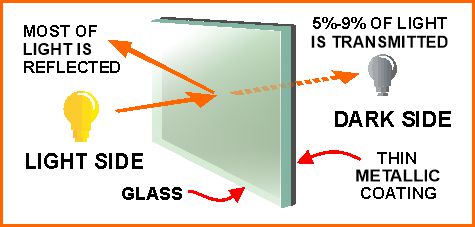
If you suspect that you are being spied on, jump to this section to find out how to identify a two-way mirror.
Table of contents
Uses of two-way mirrors
A two-way mirror is a method of seeing without being seen. Observation plays a vital role in police interrogation rooms, research (medical/psychological laboratories), in reality TV shows (Big Brother and many others), in the monitoring of employees, in focus group observation, child care facilities, and in security systems for casinos, banks, supermarkets, and airports.
In residential settings, they are used to disguise TV sets and protect computer monitors against moisture in the bathroom. Note that very high-quality dielectric mirrors are an option for wealthy customers. Technology nerds can also use the economical Raspberry Pi processor together with a two-way mirror to build a Smart Mirror.
In ballet and dance studios, loving parents can observe the performance of their children without distraction or embarrassment.
On a more macabre note, two-way mirrors are used in execution chambers where a darkened room enables witnesses to watch the death sentence being carried out.
Remember that, in all uses of two-way mirrors, the viewing room must be dark allowing the lighted room to be seen.
As an Amazon Associate, I earn from qualifying purchases
Types of two-way mirror
The three main types of two-way mirrors are glass, acrylic, and dielectric. In addition, regular glass can be made into a kind of two-way mirror by applying mirrored window film. Each option has pros and cons that are explained below.
In summary: mirrored window film is ideal for architectural applications (large existing windows), glass mirrors are best for large panels (interrogation rooms), acrylic sheets are best for small applications (TV sets), and dielectric mirrors (by far the most expensive) are best for the mansions of billionaires.
Price comparisons are shown in the table below
Retail prices of various types of two-way mirror
Glass/acrylic prices are for seamed (not polished edges) and are from Artistry in Glass for Mirrorpane, from Amazon for the acrylic mirrors, and from the Hidden Television company for the dielectric mirrors.
Prices for silver window tinting film are from this supplier on Amazon (note that film is more economical when purchased available in rolls),
| Size in | Window | 1/4″ seamed | 1/8″ | 1/4″ seamed |
| Inches | Tint Film | Mirrorpane | Acrylic | Dielectric |
| 12 X 12 | $15.00 | $16.00 | $32.50 | $173.00 |
| 12 X 24 | $20.00 | $26.00 | $64.00 | $345.00 |
| 12 X 36 | $30.00 | $36.00 | $96.50 | $518.00 |
| 24 X 24 | $35.00 | $43.00 | $128.50 | $690.00 |
| 24 X 36 | $47.00 | $61.00 | $192.50 | $1035.00 |
| 24 X 48 | $70.00 | $78.00 | $256.50 | $1380.00 |
| 36 X 48 | $84.00 | $110.00 | $384.50 | $2300.00 |
Follow this link to calculate prices for custom sizes of Mirrorpane from Artistry in Glass.
Transmittance of various two-way mirrors
As the simulation below shows, Mirrorpane has the lowest transmittance, followed by acrylic, with very expensive dielectric mirrors have the highest (>99%).
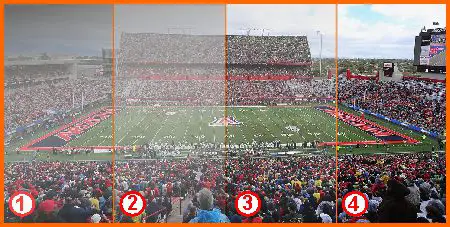
Glass two-way mirrors
The standard 2-way glass mirror available in the US is manufactured by the Pilkington Corporation out of 1/4″ thick, gray-tinted float glass and is called by the trade-name Mirrorpane. Also known as “reflective gray” in the glass business, Mirrorpane is the preferred two-way mirror for large observation windows in commercial settings because of its affordable pricing and strength.
The downside of Mirrorpane is that the gray tint makes the view a little less clear than the other varieties – this means that the contrast in lighting between the dark (observation) side and the light side must be substantial (about 10 X).
Exciting new Pilkington products including MirroView™ and MirroView™ 50/50 are ideal for concealing digital displays and video screens and come in 1/8″ as well as 1/4″ thicknesses. These are technically superior to Mirrorpane but not yet widely available – ask your glass company for samples.
Applications for glass two-way mirrors
Two-way mirrors made from 1/4″ thick glass (typically Mirrorpane) are the go-to product for all institutional and commercial secret viewing applications. The classic and most notorious application for Mirrorpane is in law-enforcement observation rooms like that shown below:
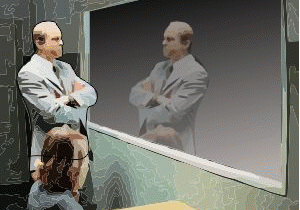
Interrogation room with Mirrorpane
Notice how the changing light controls the view in this animation of alternating lighting conditions. For correct viewing, the observer should be on the dark side and the suspect in the light.
Acrylic two-way mirrors
Acrylic two-way mirrors are more expensive than glass Mirrorpane but have the following advantages:
- Better light transmission than glass (Mirrorpane).
- Lighter in weight than glass – therefore easier to maneuver and mount.
- Flexible – can be bent into curves.
- Can be cut on a table saw (use a fine-toothed blade).
- Can be drilled much more easily than glass.
- Impact-resistant and shatterproof.
- UV-resistant (unlike glass).
Disadvantages of acrylic two-way mirror
- Less reflective than glass (Mirrorpane).
- Less rigid and strong than glass – unsuitable for large windows.
- Scratches easily – mirrored surface can be damaged.
- Should not be used outdoors as it may absorb moisture if exposed to high humidity.
1/8″ thick acrylic two-way mirror
These acrylic mirrors, available from Amazon, are currently the best deal online. Order standard sizes and cut them to fit. Ideal to place in front of your TV or computer screen.
Uses for acrylic two-way mirrors
Two-way mirrors for TV sets
In the constant search for novelty and perfection, interior designers have come up with the idea of disguising your wide-screen TV as a mirror. This makes more and more sense in the era of giant TV sets.

The best combination of price and performance for TV sets is 1/8″ thick two-way acrylic (note that infra-red TV remotes can penetrate this mirror). The most economical way, if you are a handyman or woman is to buy the acrylic and frame it to fit your TV. If you prefer you can buy framed two-way mirrors on Amazon ready to hang in front of your TV.
Two-way mirrors for bathroom TVs
For the ultimate indulgence of watching Netflix or Colombo re-runs while luxuriating in your bathtub – you need to protect the TV screen against moisture. The solution is a custom acrylic mirror applied to the TV. Make your own or purchase one like this on Amazon:
Bathroom Magic Mirror
A two-way mirror shows TV programs when turned on and a mirror when turned off. The TV is waterproof and comes with 2-piece speakers and a waterproof remote control.
Dielectric two-way mirrors
According to Wikipedia dielectric mirrors rely on the interference of light reflected from multiple layers of dielectric material. Numerous variations are available for specialized scientific applications (lasers, telescopes, microscopes, etc) but large sheets for architectural uses are made in the US by the Guardian and Pilkington companies using a substrate of low-iron “Starfire” (crystal clear) glass to ensure maximum clarity. Both companies offer two types with different values of reflectance and transmittance.
The bottom line is that dielectric mirrors are highly transparent and, placed in front of a TV screen, offer flawless picture quality when the set is on and almost perfect (> 99%) reflectance when the set is off. (This compares with 90-95% reflectance for standard silver mirrors).
Silver window film
Window films are used primarily to reduce solar heat, glare, and UV light in residential and commercial settings but, as a side benefit, they can also act as a type of two-mirror. When reflective tinting is placed on the outside of a building, the occupants can see out of the windows but cannot be seen from the outside. The benefit is privacy for the office workers or homeowners – the opposite of the normal function of two-way mirrors.

Silver window tinting on office building
Solar window tinting reflects 60% of the light protecting the interior from heat and UV light. Occupants on the darker inside of the building can see out – they can see and not be seen!
Window Film Privacy Tint
This static-cling window mirror film, available on Amazon, is easy to apply. Controls heat and UV light and allows the occupants to look out from the interior.
Smart Mirror computer screens
A smart mirror, also known as a magic mirror, displays the time, weather, calendar, news, and social media updates. The magic is created by placing a transparent mirror over a screen such as a tablet, monitor, or TV. The technology is driven by a Raspberry Pi or Windows PC, combined with voice recognition and touch technology.
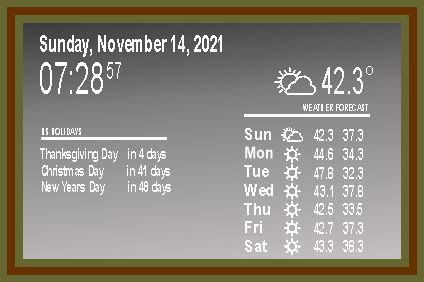
Smart Mirror showing computer data
Raspberry Pi processor (Amazon) can be easily hooked up to a two-way acrylic mirror to project dates, news, weather, and other info. Ideal gadget for the tech-savvy homeowner.
Vilros Magic Mirror
This two-way mirror available on Amazon acts as a “Smart Mirror” for a Raspberry Pi processor. It includes internal 1920 * 1080 pixel, ready-to-connect LCD. Buy a motherboard and you are ready to go.
Illegal use of two-way mirrors
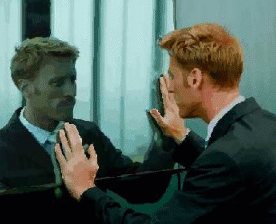
Voyeur spying on his victim
If you are using a mirror in a hotel, public bathroom, or unfamiliar location, there is the remote possibility that it may be a two-way mirror. Follow the steps outlined below to check.
How to recognize a two-way mirror
Most two-way mirrors in the US are made from Mirrorpane (gray-tinted glass) and therefore appear darker and less shiny than a typical clear glass mirror. However, some conventional mirrors are also made with tinted (often bronze or gray) glass so the color of the mirror is not definite evidence. Use the following tests to be sure.
Examine the installation method
If the mirror is hanging on a wall, or if the mirror is attached with clips and glue then it is very unlikely to be two-way. In other words, if you can deduce that a solid wall is behind the mirror – you are safe.
Try the finger touching test
The images below show that, with a conventional mirror, there is a small gap between the fingertip and its reflected image. This gap represents the thickness of the glass (typically 1/4″). With the two-way mirror, viewed from the reflective side, the finger and its image touch each other.
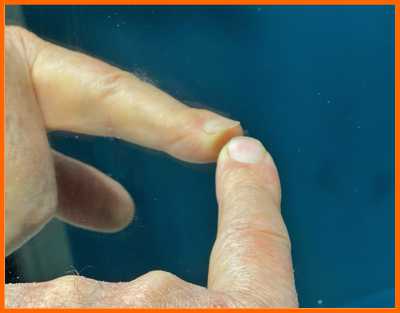
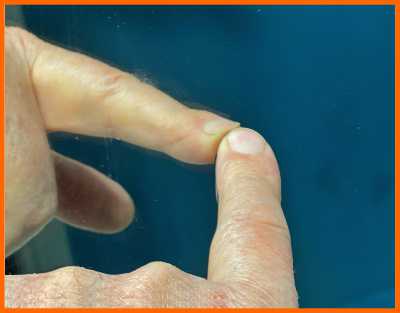
Use the flashlight test
Since light can be transmitted through a two-way mirror, it should be possible to see through to the other side with the aid of a flashlight or smartphone light. With no flashlight available, shade your eyes from the room light by cupping your hands around the side of your face – then peer closely into the mirror to see if anything is visible.
Try the hollow wall test
It is obvious that a two-way mirror cannot function if it is attached to a solid wall. So tapping the surface should give a hollow sound – revealing the hidden observation room or camera cavity on the other side. Try this test with care – it is easy to crack a mirror.
If you discover a two-way mirror
In the unlikely event that you discover a two-way mirror in a public restroom or changing room, you should report this to the authorities. Two-way mirrors are unlawful in most states, for example, in California: “Any person who installs or who maintains after April 1, 1970, any two-way mirror permitting observation of any restroom, toilet, bathroom, washroom, shower, locker room, fitting room, motel room, or hotel room, is guilty of a misdemeanor.”
Cost calculator for Mirrorpane
Two-way mirrors from Artistry in Glass
US glass and mirror shops call two-way mirror either “mirrorpane”, or “reflective gray”. It is made from 1/4″ thick tinted (gray) float glass with a thin metallic (aluminum) coating and can be polished or beveled just like a regular mirror. The prices on this website are from Artistry in Glass in Tucson but may be higher in larger metropolitan areas. If your two-way mirror will be framed or installed behind a “stop”, save money by requesting a seamed edge rather than more expensive polished or beveled edges. To learn the difference between seamed & polished follow this link.
For all mirror work in Tucson & Southern Arizona call the experts at Artistry in Glass
Unique Mirror Resources from Artistry in Glass
Mirror Design & layout
- How are mirrors made?
- What is a beveled mirror?
- What is a two-way mirror?
- Best mirrors for bedrooms
- How to size and position your wall mirror
- How to order custom etched mirrors
- Best places to hang dining room mirrors
- How much do wall mirrors cost?
- Shop the MIRROR Family Package
Mirror Installation & Removal
- How to hang a wall mirror
- How to frame a builder’s grade bathroom mirror
- How to hang a frameless mirror with glue
- Best clips for hanging mirrors
- How to attach a mirror to a closet door
- How to remove a mirror glued to the wall
Mirror Repair & Restoration
- Should I resilver my antique mirror?
- Can I repair scratched mirror silvering?
- What is the best spray paint for mirror silvering?
- How to fix a cracked mirror
- How to repair a broken mirror frame
Glass safety – learn from the experts!
- Choosing between tempered & laminated glass
- Broken glass injuries and how to avoid them
- Is wired glass safe?
- What is safety glass?
- What is tempered glass?
- What is Gorilla Glass?
- Plexiglass vs glass
- Should glass shelves be tempered?
- Should glass tabletops be tempered?
- Is lead crystal dangerous?
- Is leaded (stained) glass dangerous?
- How to repair cracked stained glass
Artistry in Glass was your source for antique repair in Tucson
Check out this amazing selection of informative articles:-
- Where can I get antiques repaired?
- Are broken antiques worth fixing?
- How to fix a broken picture frame
- How to repair a broken china plate
- How to repair a broken china teapot
- How to fix a broken marble slab
- How to repair a broken china coffee mug
- How to repair a 2000-year-old sculpture
- All about repairing stained-glass lampshades
- How to care for your stained glass skylight
- How to repair Dalle de Verre
- Is stained glass worth repairing?
- To repair or toss out?
- Tucson crystal & china repair a division of Artistry in Glass
- What to do with broken antiques
- Is lead crystal dangerous?
- Repairing an antique Mexican statue
- Repairing religious statues
- The history of Swarovski crystal figurines
- How to find the value of a Swarovski Crystal figurine
- Have Swarovski crystal figurines lost value since 2009?
- How to collect Swarovski annual ornaments
- How to display Swarovski crystal figurines
- How to authenticate a Swarovski crystal figurine
- How to display Swarovski annual ornaments
- How to clean Swarovski crystal figurines
- How to repair a Swarovski crystal mouse
- How to repair a Swarovski annual ornament
- How to repair a Swarovski crystal train set
- Fixing broken wine glass stems
- How to clean cloudy glasses
- Why do wine glasses have stems?
- Swarovski Crystal Figurines
- How to repair a chip in a wine glass
- How to fix a scratched glass tabletop
- How to replace a broken patio tabletop








